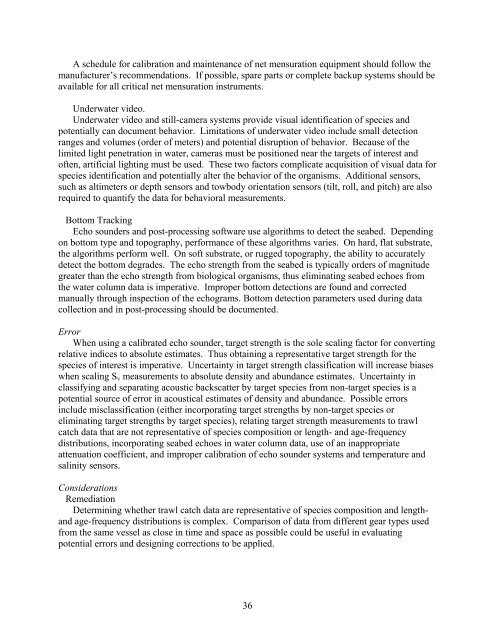NOAA Protocols for Fisheries Acoustics Surveys and Related ...
NOAA Protocols for Fisheries Acoustics Surveys and Related ...
NOAA Protocols for Fisheries Acoustics Surveys and Related ...
Create successful ePaper yourself
Turn your PDF publications into a flip-book with our unique Google optimized e-Paper software.
A schedule <strong>for</strong> calibration <strong>and</strong> maintenance of net mensuration equipment should follow the<br />
manufacturer’s recommendations. If possible, spare parts or complete backup systems should be<br />
available <strong>for</strong> all critical net mensuration instruments.<br />
Underwater video.<br />
Underwater video <strong>and</strong> still-camera systems provide visual identification of species <strong>and</strong><br />
potentially can document behavior. Limitations of underwater video include small detection<br />
ranges <strong>and</strong> volumes (order of meters) <strong>and</strong> potential disruption of behavior. Because of the<br />
limited light penetration in water, cameras must be positioned near the targets of interest <strong>and</strong><br />
often, artificial lighting must be used. These two factors complicate acquisition of visual data <strong>for</strong><br />
species identification <strong>and</strong> potentially alter the behavior of the organisms. Additional sensors,<br />
such as altimeters or depth sensors <strong>and</strong> towbody orientation sensors (tilt, roll, <strong>and</strong> pitch) are also<br />
required to quantify the data <strong>for</strong> behavioral measurements.<br />
Bottom Tracking<br />
Echo sounders <strong>and</strong> post-processing software use algorithms to detect the seabed. Depending<br />
on bottom type <strong>and</strong> topography, per<strong>for</strong>mance of these algorithms varies. On hard, flat substrate,<br />
the algorithms per<strong>for</strong>m well. On soft substrate, or rugged topography, the ability to accurately<br />
detect the bottom degrades. The echo strength from the seabed is typically orders of magnitude<br />
greater than the echo strength from biological organisms, thus eliminating seabed echoes from<br />
the water column data is imperative. Improper bottom detections are found <strong>and</strong> corrected<br />
manually through inspection of the echograms. Bottom detection parameters used during data<br />
collection <strong>and</strong> in post-processing should be documented.<br />
Error<br />
When using a calibrated echo sounder, target strength is the sole scaling factor <strong>for</strong> converting<br />
relative indices to absolute estimates. Thus obtaining a representative target strength <strong>for</strong> the<br />
species of interest is imperative. Uncertainty in target strength classification will increase biases<br />
when scaling S v measurements to absolute density <strong>and</strong> abundance estimates. Uncertainty in<br />
classifying <strong>and</strong> separating acoustic backscatter by target species from non-target species is a<br />
potential source of error in acoustical estimates of density <strong>and</strong> abundance. Possible errors<br />
include misclassification (either incorporating target strengths by non-target species or<br />
eliminating target strengths by target species), relating target strength measurements to trawl<br />
catch data that are not representative of species composition or length- <strong>and</strong> age-frequency<br />
distributions, incorporating seabed echoes in water column data, use of an inappropriate<br />
attenuation coefficient, <strong>and</strong> improper calibration of echo sounder systems <strong>and</strong> temperature <strong>and</strong><br />
salinity sensors.<br />
Considerations<br />
Remediation<br />
Determining whether trawl catch data are representative of species composition <strong>and</strong> length<strong>and</strong><br />
age-frequency distributions is complex. Comparison of data from different gear types used<br />
from the same vessel as close in time <strong>and</strong> space as possible could be useful in evaluating<br />
potential errors <strong>and</strong> designing corrections to be applied.<br />
36
















